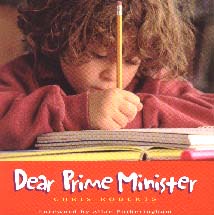| ________________CM
. . . . Volume VIII Number 2 . . . . September 21, 2001
excerpt: "Dear Prime Minister":This book could be compared to question period in the House, except for the nature of the questions which does tend toward the personal! Certainly almost all of the correspondents request a reply as soon as possible---a similarity to Question Period! For example, Jack in Whitehorse writes:"This is for my autobiography, so hurry [to write back soon]." The children writing these letters range in age from six to twelve, and their thinking on what role the Prime Minister plays in Canada from Santa Claus ("I want a Pokemon poster, a big water gun, a new bike... I will leave some cookies for you.") to someone who has a pretty good life. ("Are you in charge of guns? Are you in charge of wars? I am only six and I think you have a fun job." "I hear you make lots of money and you can do anything you want." "One day I would like to be Prime Minister. Do you have to go to school to be Prime Minister?") Between these extremes are children who are seriously worried about pollution, the ozone layer ("I think people who smoke should not do it because it causes a big hole in the ozone layer. If the hole gets bigger and pops, we will all have to wear gas masks."), destruction of the environment ("I do not like that trees are being cut down and that animals are becoming extinct."), and cruelty to animals ("I think that cats and kittens should get free food for a year. My cat agrees with this.") The criterion for inclusion in this volume seems to have been to strike a balance between cute and concerned, and, in this, it succeeds. My question, however, (not directed to the Prime Minister), is "Why?" Both, why the book and also why the letters initially? The answer to the former is probably that, like Everest, they were there for the collecting. The answer to the latter would appear to be "Because the teacher told me to." The word "project" occurs again and again and again in these letters, though not all children are as frank as Ann of Burlington who says, "Our class has to write a letter to you as a project. I don't really want to because I have nothing to say to you. I don't know if you do a good job or a bad job. I don't even know what you look like or if you are a boy or a girl. That's about all." I am in favour of projects. Kids do---and enjoy---many things because they have been made to do them, and learning how to write a letter is a very useful skill. BUT...it seems unfair to bother politicians and authors of children's books with the results of this learning process merely because these groups are constrained by the nature of their jobs to be anything but polite about such nuisances. And, frankly, the results don't justify being turned into a book. Not Recommended. Mary Thomas works in two elementary schools in Winnipeg, MB, and has heard author Jean Little (but not Jean Chretien!) sound off on the subject of bundles of "project" letters.
To comment on this title or this review, send mail to cm@umanitoba.ca. Copyright © the Manitoba Library Association. Reproduction for personal use is permitted only if this copyright notice is maintained. Any other reproduction is prohibited without permission. Published
by
NEXT REVIEW | TABLE OF CONTENTS FOR THIS ISSUE - September 21, 2001. AUTHORS | TITLES | MEDIA REVIEWS | PROFILES | BACK ISSUES | SEARCH | ORDER | CMARCHIVE | HOME |
